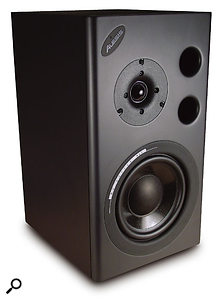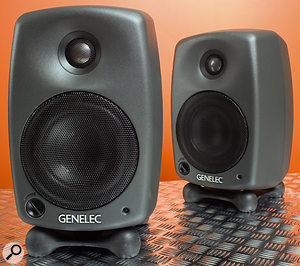 The Alesis M1 MkII actives offer well-balanced sound and good value for money.
The Alesis M1 MkII actives offer well-balanced sound and good value for money.
I am currently setting up a small recording studio based on a Yamaha AW16G recording system and require some active nearfield monitors. I have been reading your excellent magazine for some months and, although I am more clued up than I was six months ago, I am still no clearer on what monitors are best suited to me. I want to record mainly British traditional music using a variety of acoustic instruments, including guitars, mandolin, bouzouki, Irish whistle and bodhran alongside vocals. I have a budget of about £200 to £500 for a pair of active nearfield monitors but would be happy to pay more if a noticeable benefit could be obtained. What do you recommend? My studio is about 12 x 9 feet in size.
Vince Jerrison
 Genelec's 8020A is the baby of their active monitor range, but it still packs a punch. Editor In Chief Paul White replies: In a studio of that size, an active two-way monitor with a five-inch to eight-inch bass driver would be ideal. For 'acoustic' music, soft-dome tweeters often give the most natural response (although some metal designs also sound very good) and at the budget end of your price range I'd be inclined to look at the Alesis M1 MkII Actives (reviewed in SOS way back in August 2002) and the Fostex PM05 monitors, as I feel these would work well for your style of music and your room size. Tannoy Reveals are also well worth looking at.
Genelec's 8020A is the baby of their active monitor range, but it still packs a punch. Editor In Chief Paul White replies: In a studio of that size, an active two-way monitor with a five-inch to eight-inch bass driver would be ideal. For 'acoustic' music, soft-dome tweeters often give the most natural response (although some metal designs also sound very good) and at the budget end of your price range I'd be inclined to look at the Alesis M1 MkII Actives (reviewed in SOS way back in August 2002) and the Fostex PM05 monitors, as I feel these would work well for your style of music and your room size. Tannoy Reveals are also well worth looking at.
At the top of your range, I'd be tempted to look at KRK's range of monitors, along with products from Dynaudio and Genelec's recent 8020As. If you can stretch your budget further, the Mackie HR624s should work well for you and there are also some great monitors at the more affordable end of the ADAM range. If you can find a shop that will lend or hire the speakers to you so that you can check they're giving the results you want in your room, it's well worth it, even if you end up paying a bit more.
Note that these recommendations are based on speakers that I've used for a meaningful amount of time, so there may be other equally worthy contenders that I haven't included purely because I don't feel I know them well enough. It's also worth mentioning that proper speaker mounting and positioning is important, as is acoustic treatment — even the best monitors won't give great results in an untreated room.
To find out more, check out our in-depth guide to monitoring and acoustic treatment in SOS February 2006.
